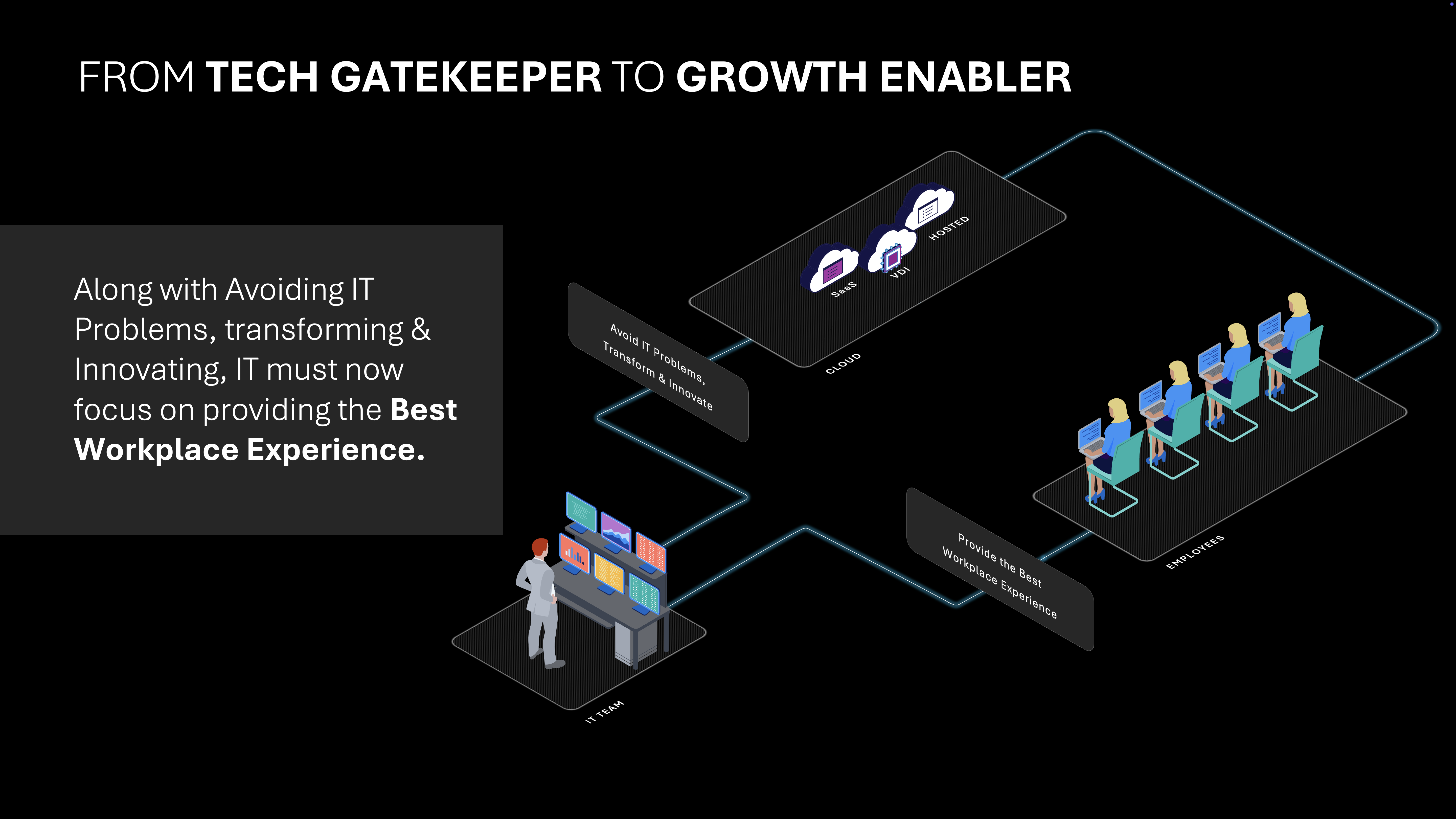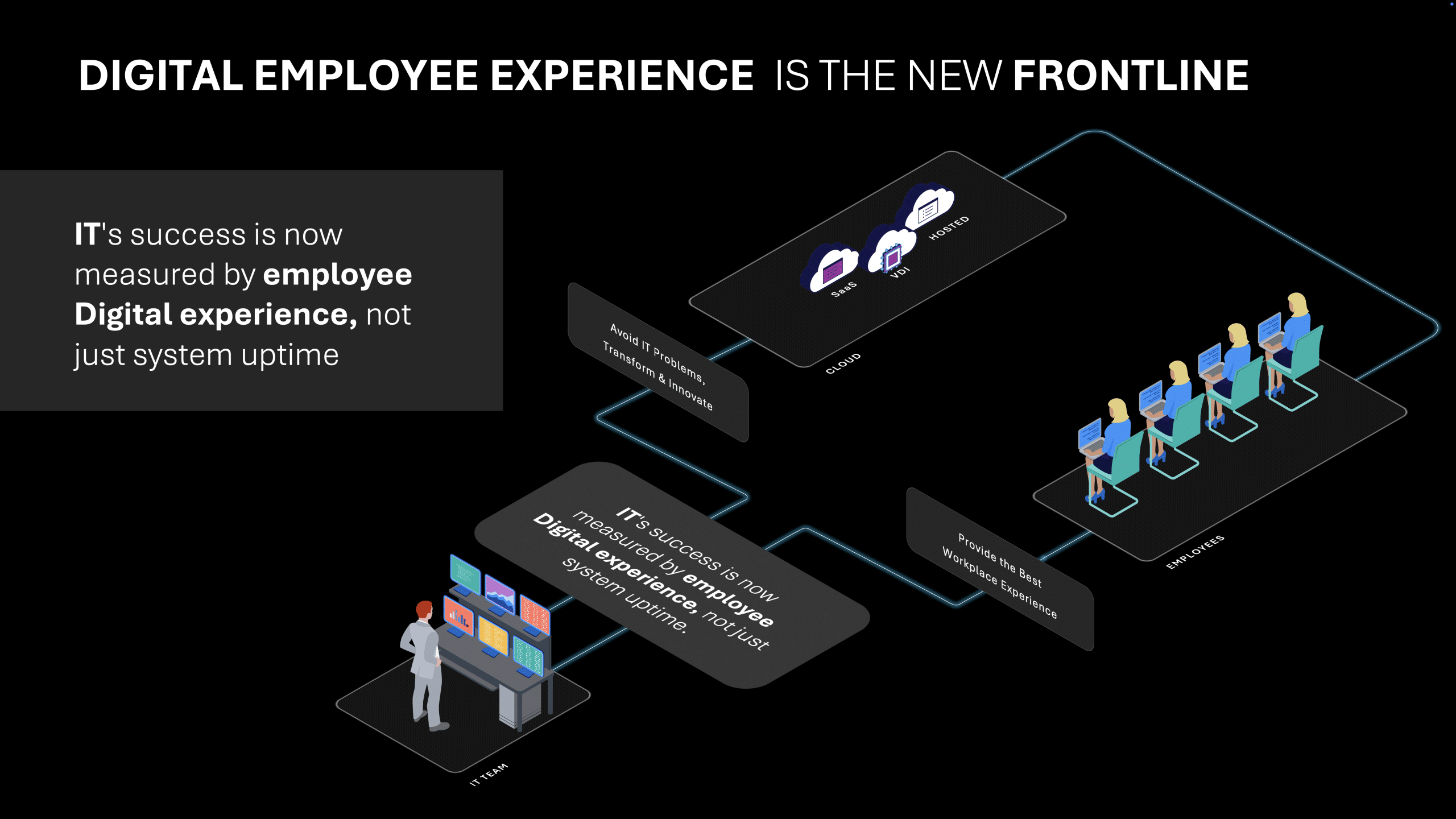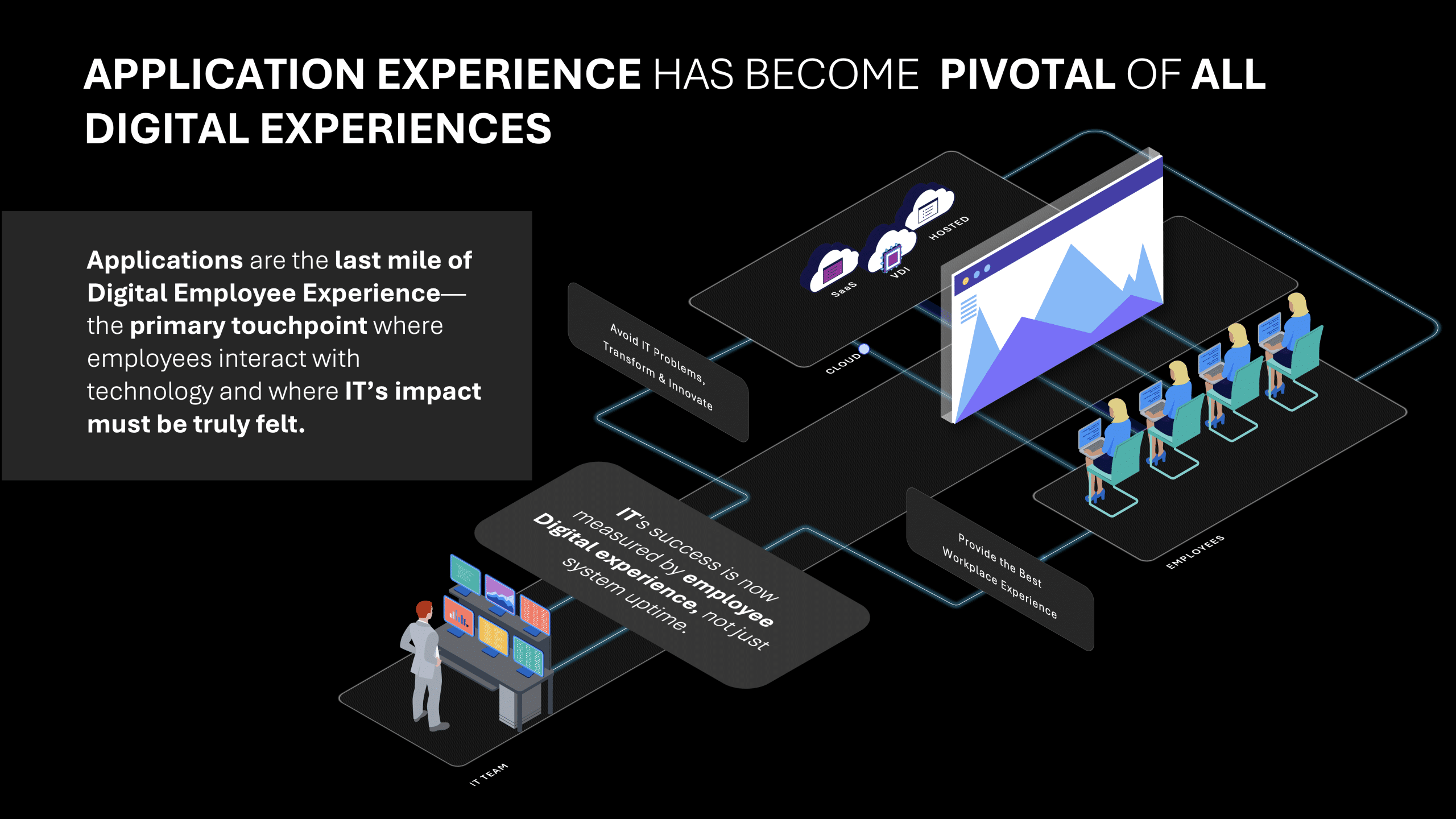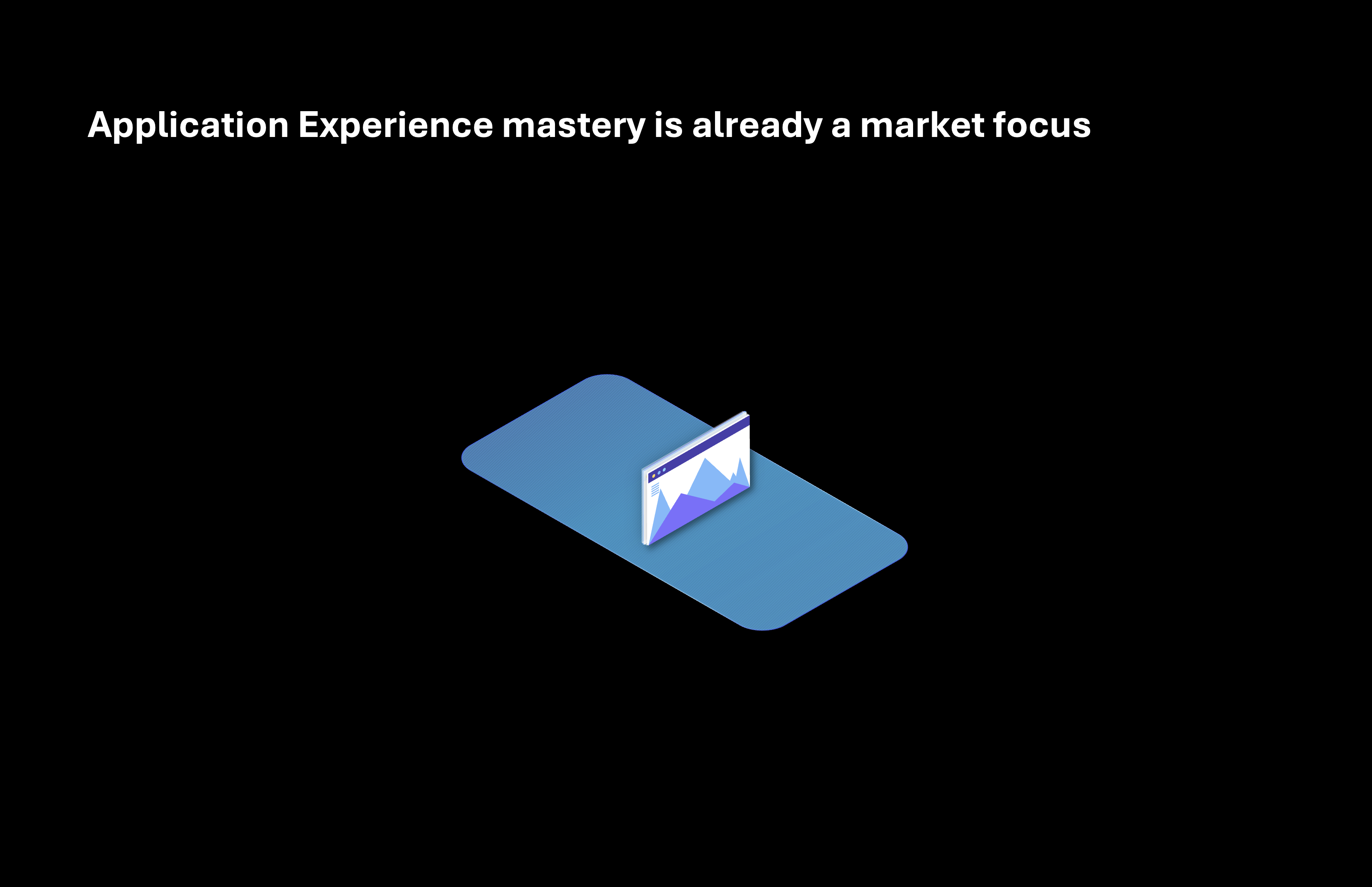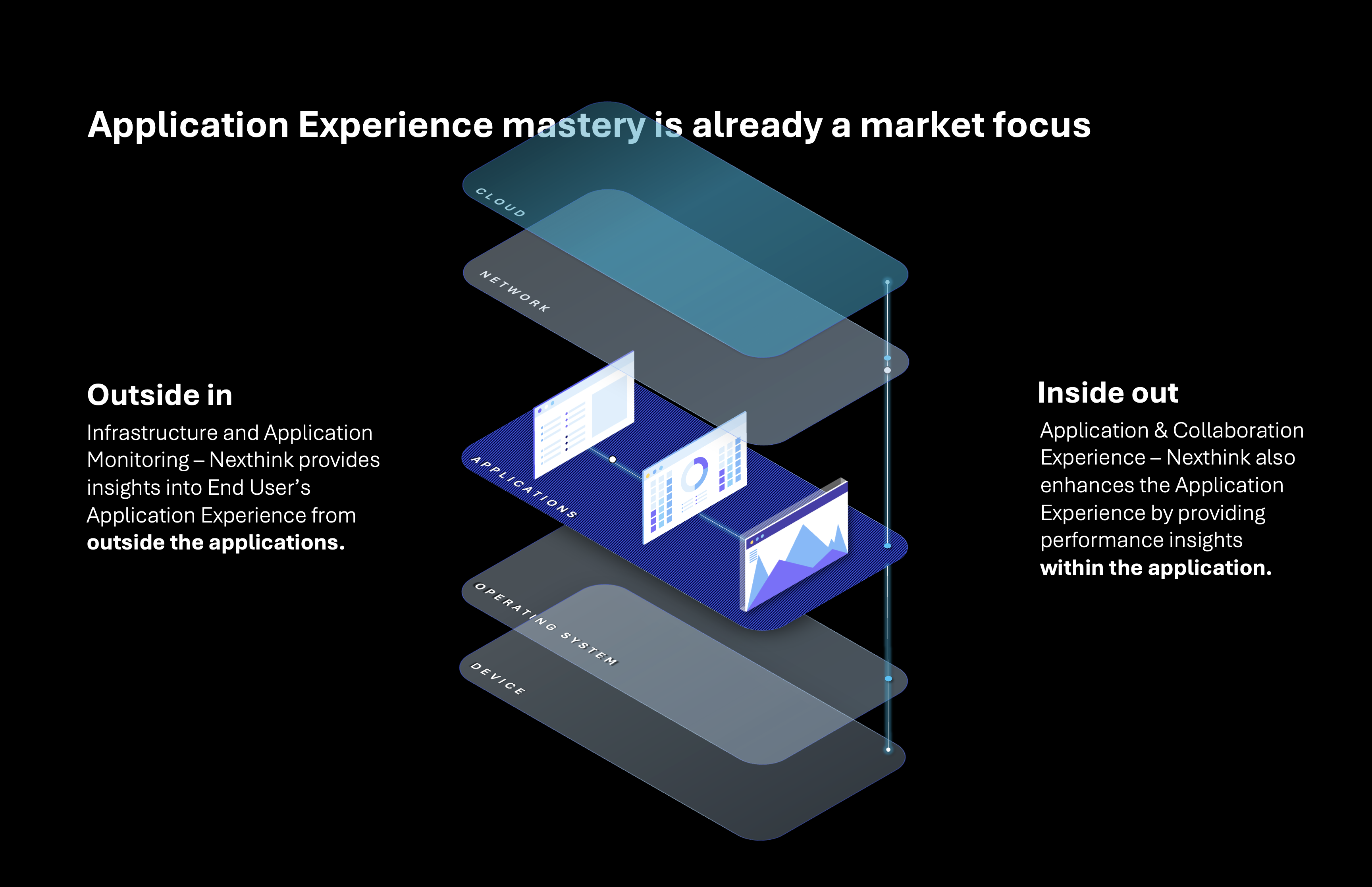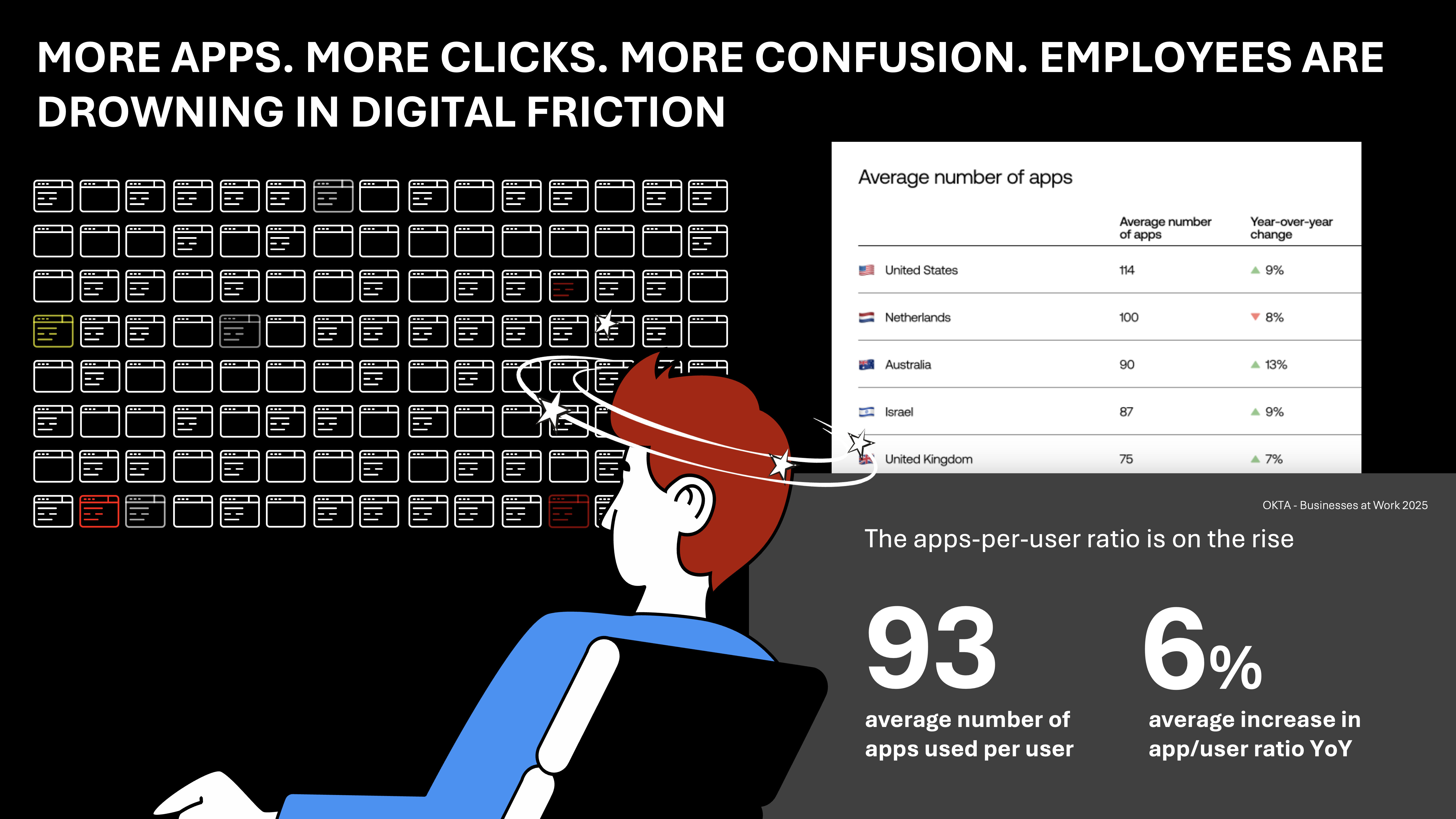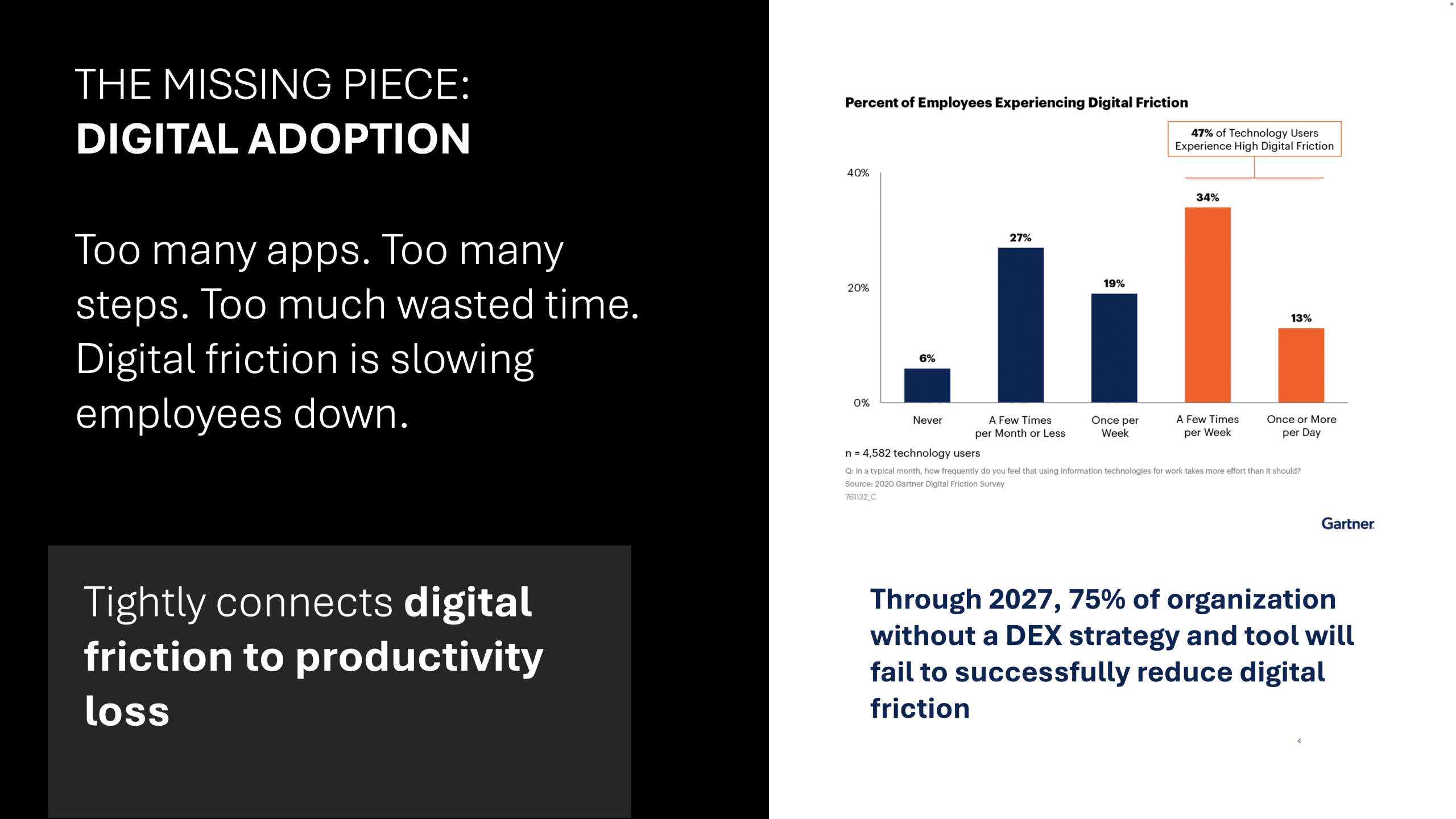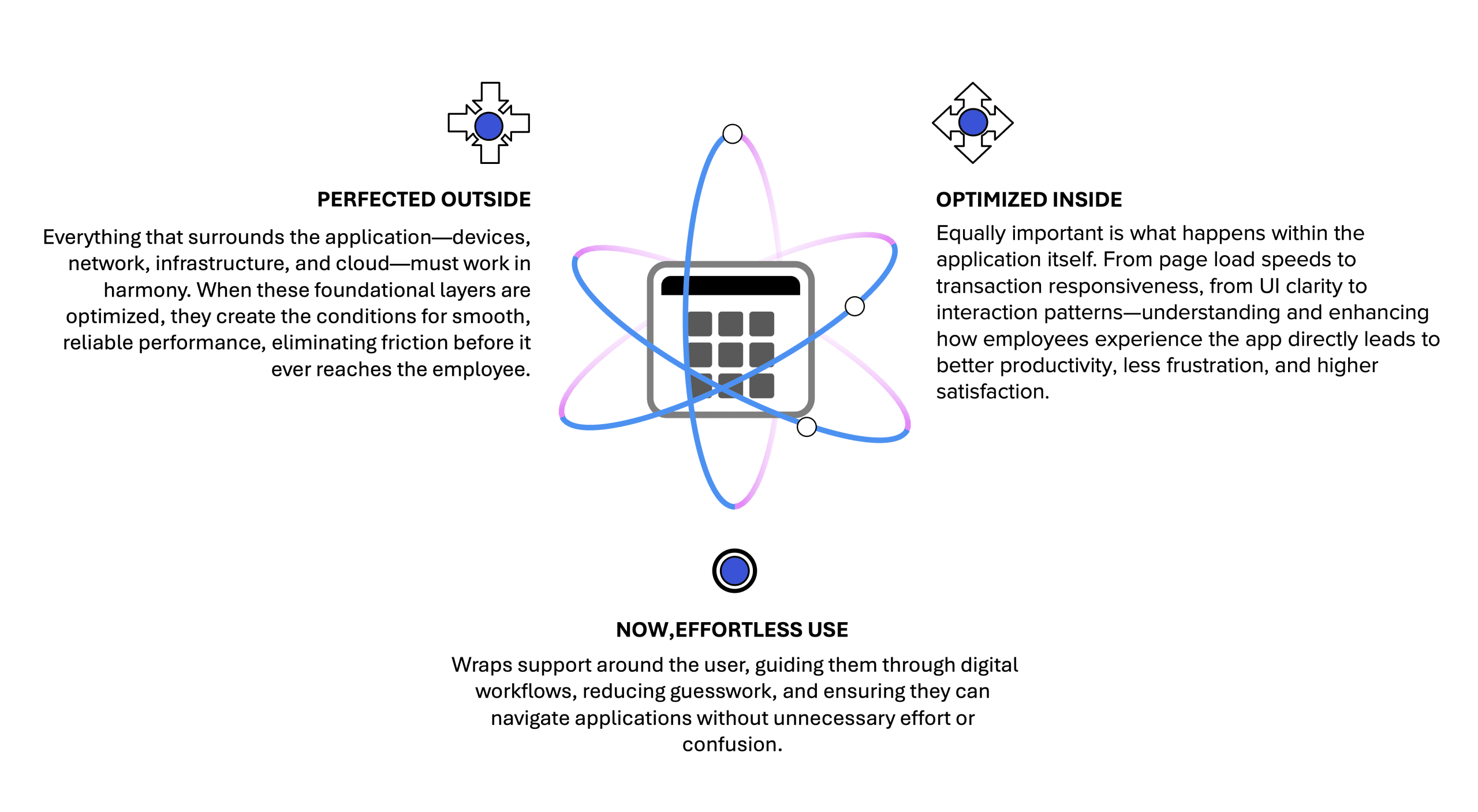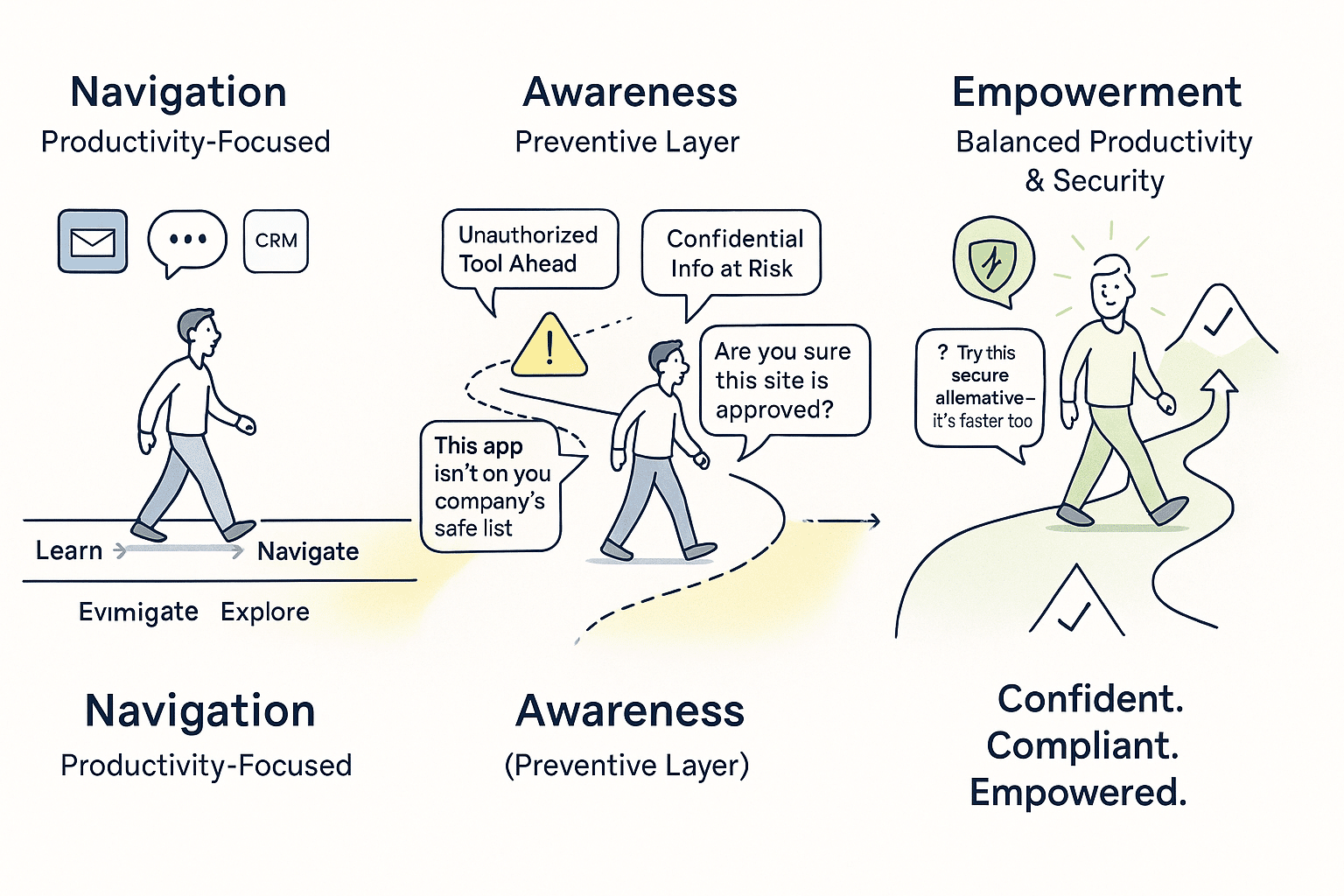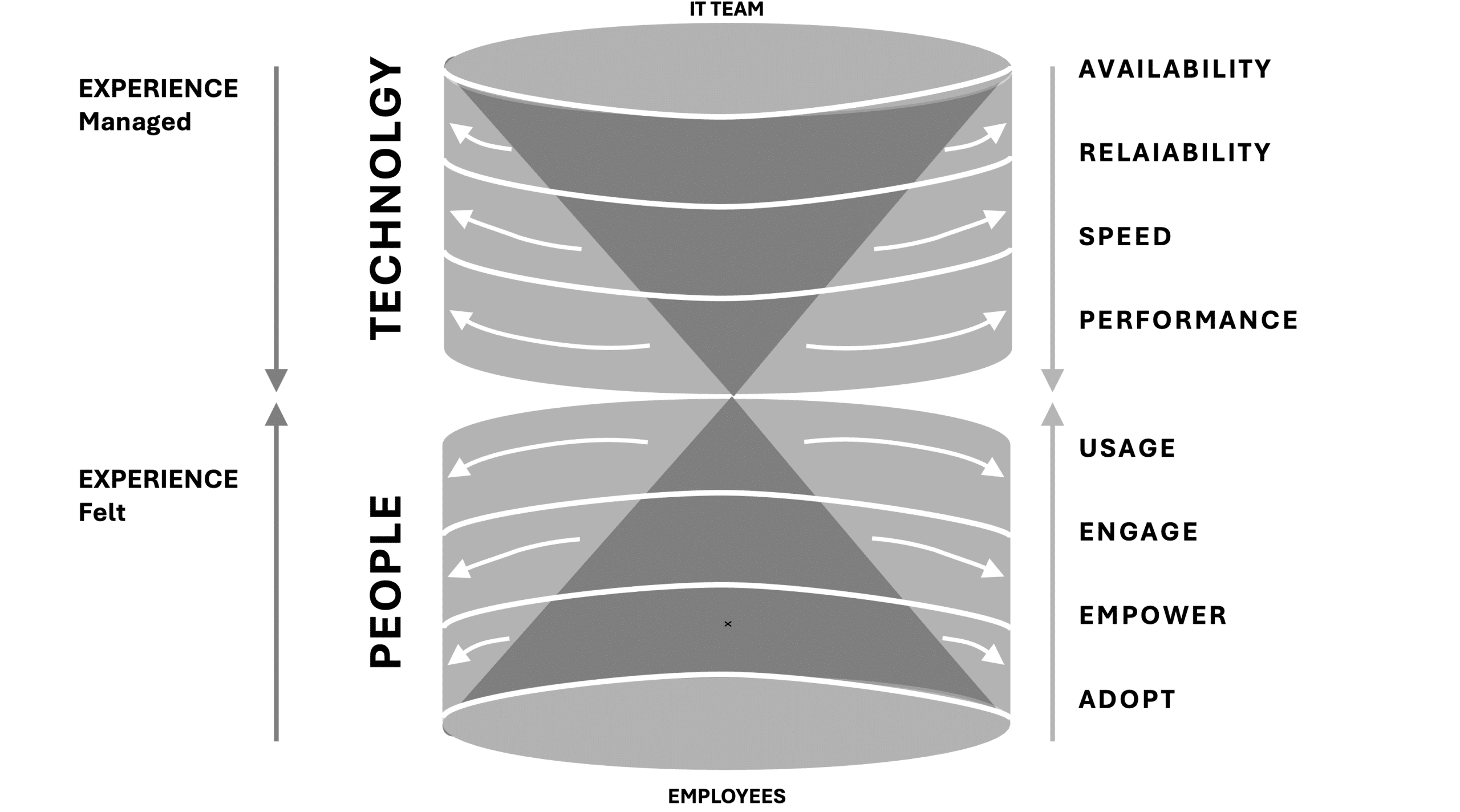This isn’t a quick-read blog. It’s a one-stop reference—designed for those who want to truly understand Digital Adoption. From fundamentals to frameworks, market research to sales narratives, it brings together everything in one place—especially the link between Digital Adoption and Digital Employee Experience (DEX). Use it how it serves you best: • Skim the headlines. • Deep-dive where it matters. • Come back when you need to pitch or sell Digital Adoption smarter. Not just a read. A resource.
The Human Struggle We Overlook
We have stabilized systems, modernized apps, accelerated cloud migrations, and automated support. Yet employees still struggle. Not because technology is broken, but because their experience of using that technology is overwhelming and fragmented.
Despite the technical success, the human experience remains fractured.
The issue today is not technology downtime. It is human downtime.
Gartner defines Digital Friction as “the unnecessary effort employees must exert to use technology for their work.”
- 36 workdays lost annually per employee (Gartner)
- $104 million lost annually by large enterprises due to inefficiencies (Forrester)
Digital friction doesn’t crash systems; it crashes human flow. It’s the silent tax that drains productivity, innovation, and employee morale without ever raising a ticket.
How to Make Your Digital Workplace Happier, Faster and Smarter?
The New Mandate for IT: Experience Over Infrastructure
Traditional IT success was about system uptime. Infrastructure was king.
Today, even when systems are “up,” employees can feel “down.” Work environments saturated with apps and tools don’t always translate to seamless workflows.
IT is no longer a cost center—it’s a business enabler.
Companies that leverage IT strategically don’t just survive; they lead. It’s about moving from reactive firefighting to proactive value creation.
Why is This Change Happening?
The speed of digital transformation is increasing. IT now plays a direct role in business growth, innovation, and experience. Data, automation, and analytics are giving IT leaders real-time insights to make smarter decisions.
IT must move beyond infrastructure and focus on business impact. Leveraging technology, AI, and analytics enables efficiency and new opportunities.
The shift is from “keeping things running” to “steering the future.”
The modern IT mandate isn’t about systems being online. It’s about humans being able to flow.
Metrics have shifted:
- From uptime to adoption rates
- From incident closure to experience quality
- From deployment to flow enablement
The Evolution of IT’s Role
IT has shifted from being a gatekeeper to becoming a growth enabler.The goal is to empower users with the right tools and ensure every digital interaction is smooth and efficient.
Beyond Just Avoiding IT Problems
Historically, IT was all about keeping the lights on—preventing downtime, avoiding security breaches, and fixing issues after they occurred.That approach was necessary, but it’s not enough in today’s fast-paced digital world.
Gartner (2023)
reported that 70% of digital transformation failures stem from reactive IT operations that focus on break/fix rather than proactive experience management.
Transforming & Innovating
Modern IT isn’t just reactive; it’s transformative. IT teams are now expected to lead innovation—adopting new technologies and streamlining processes.They’re not only troubleshooting but also reimagining the way work gets done.
Gartner’s IT Score
for Infrastructure and Operations emphasizes that CIOs are being evaluated on digital innovation enablement, not just uptime.
Focusing on the Best Workplace Experience
Along with avoiding problems and driving innovation, IT must now ensure the best possible workplace experience. This means creating a seamless, engaging digital environment where employees can perform at their peak.
Forrester’s DEX Study (2023)
found that companies investing in Digital Employee Experience (DEX) saw a 20–30% rise in employee satisfaction and a 15% increase in retention.
Today, the real measure of IT success is Employee Digital Experience, Because productivity isn’t just about working systems—it’s about seamless, frustration-free experiences.
Employees don’t care if their device is “technically operational”—they care if:
- Their apps load instantly.
- Their laptop doesn’t freeze in the middle of a meeting.
- They can work without interruptions.
- A bad digital experience = wasted time, frustration, and lost efficiency.
The New IT Success Metric: DEX Over Uptime
IT teams are now being evaluated based on:
- How smoothly employees can work (not just if systems are running).
- How proactive IT is in preventing digital disruptions (not just reacting to tickets).
- The overall digital satisfaction of employees—because unhappy employees = lower business performance.
Workplace Experience Measurement
through Experience Level
Agreements (XLAs)
Application Experience is the Most Pivotal of All Digital Experiences
Applications are the primary touchpoint where employees interact with technology to perform their work—making them the ‘last mile’ of the digital experience.
No matter how stable the IT infrastructure is, if the applications employees rely on are slow, unresponsive, or crash frequently, productivity takes a direct hit.
Furthermore, no matter where an issue originates—whether it’s the device, network, backend systems, or cloud infrastructure—the employee will feel its impact while using the application. IT’s impact must be truly felt here—where technology meets the end user.
A seamless, high-performing application experience is no longer optional; it defines the success of Digital Employee Experience itself.
Applications: The Last Mile of Digital Experience
- No matter how good IT infrastructure is, if the applications employees use daily don’t work smoothly, the experience fails.
- Why?
- Applications are the primary touchpoint between employees and technology.
- Every lag, crash, or login failure directly impacts productivity and frustration levels.
- IT’s success must be truly felt at this last mile—where employees interact with their tools.
Why Application Experience is the True Measure of IT’s Impact
- A slow device is annoying—but a slow application can bring work to a halt.
- Even if a system is “up,” if applications are unresponsive or slow, employees struggle to get work done.
- Application experience determines the real-world success of IT efforts—because it directly affects employee efficiency.
Mastering Application Experience: What the Market Solves — and What It Misses
Today, many organizations and solution providers recognize that Application Experience is the most pivotal part of Digital Employee Experience (DEX), and offer experience management approaches that dive deep into applications — both from the Outside-In and the Inside-Out perspectives.
Outside-In
Focusing on everything that surrounds the application — network performance, device health, operating system efficiency, cloud infrastructure stability — to create the conditions necessary for smooth application operation.
To ensure flawless application performance, it’s critical to look beyond the app itself and focus on the broader ecosystem surrounding it. This Outside-In perspective considers all the foundational layers that support the app—such as network performance, where latency can delay data flow; device health, where CPU, memory, or disk issues can bottleneck operations; operating system efficiency, which can introduce lag or instability; and cloud or backend infrastructure, where slow API calls or service disruptions can severely impact responsiveness. By tuning these underlying systems, organizations can create the ideal conditions for applications to perform seamlessly—ultimately enhancing the overall digital employee experience.
Inside-Out
Diving directly into the application experience itself — measuring page load times, transaction speeds, responsiveness, usability, and interaction patterns to ensure that employees engage seamlessly with the tools they rely on.
The Inside-Out perspective dives directly into the heart of the application experience, focusing on how employees actually interact with the tools they use every day. It involves tracking key performance and usability indicators such as page load times, transaction responsiveness, UI design clarity, and user interaction patterns. These insights reveal where employees encounter friction—whether it’s a slow-loading dashboard, a confusing interface, or repetitive, inefficient workflows. By analyzing these signals, IT and business teams gain a clear understanding of how users feel during their digital journey, allowing them to make targeted improvements that truly elevate the application experience and, in turn, the overall employee experience.
This dual-layered mastery gives IT teams full visibility — not just into backend system performance, but into the real, felt experiences employees have when navigating digital workflows.
It’s a powerful advancement.
But is it enough?
Even with the most sophisticated monitoring inside and outside applications, the critical question remains:
Does this guarantee that employees can work without friction? Does visibility alone eliminate the struggles employees feel when trying to adopt, use, and thrive with digital tools?
The Application Experience Paradox
In an effort to boost productivity, organizations have embraced an explosion of digital tools. More applications. More features. More platforms. More everything.
The logic seemed simple:
More technology = more efficiency.
But reality tells a different story.
The numbers say it all:
- On average, employees now use 93 different applications to get their work done (Okta).
- This number is growing by 6% year-over-year.
- In some regions, like the U.S., it’s even higher — reaching 114 apps per employee.
Businesses at Work 2025
More apps should mean more empowerment… right?
Instead, it’s leading to more clicks, more confusion, more cognitive load and more frustration.
Employees are trapped in endless switching between systems, buried under complex interfaces, and constantly struggling to find, complete, and deliver their work efficiently.
- Every extra click.
- Every unnecessary pop-up.
- Every second of delay.
- Every re-login, every context switch.
It all adds up silently, invisibly.
Gartner has a name for this hidden productivity tax:
Digital Friction — the unnecessary effort employees must exert just to use workplace technology.
When employees are drowning in digital friction, productivity suffers, engagement drops, and frustration builds.”
“So what’s the real problem behind all this?”
Digital Adoption
We’ve seen how more apps, more clicks, and more complexity are overwhelming employees, creating what Gartner calls Digital Friction. But what’s the real missing piece?
What’s the key to turning technology from a burden into a true enabler?
The answer is Digital Adoption.
Think of Digital Adoption as the last drops of oil that keep the Digital Experience gears running smoothly. Without it, even the best applications, the most optimized networks, and the most powerful devices still lead to frustration and lost productivity.
And the numbers prove it. Nearly 47% of employees experience high digital friction, struggling to navigate the very tools meant to help them work. If this friction isn’t addressed, it doesn’t just slow down employees—it erodes business performance.
That’s why Gartner makes it clear: by 2027, 75% of organizations without a Digital Employee Experience (DEX) strategy and tools will fail to reduce digital friction.
The message is simple—
Without an intentional focus on Digital Adoption businesses will continue to lose productivity and engagement.
So, how do we bridge this gap? How do we ensure employees don’t just have access to technology—but truly adopt and benefit from it?”
What’s the point of great apps if employees struggle to adopt and use them effectively?
Perfected Outside: Everything that surrounds the application—devices, network, infrastructure, and cloud—must work in harmony. When these foundational layers are optimized, they create the conditions for smooth, reliable performance, eliminating friction before it ever reaches the employee.
Optimized Inside: Equally important is what happens within the application itself. From page load speeds to transaction responsiveness, from UI clarity to interaction patterns—understanding and enhancing how employees experience the app directly leads to better productivity, less frustration, and higher satisfaction.
Still Not Enough
Even with flawless infrastructure, responsive networks, healthy devices, and well-performing applications, the job isn’t done. Because employees don’t just need working tools—they need guidance.
That’s where Effortless Use at the Core comes in.
It wraps the support experience around the user—helping them navigate digital workflows, understand unfamiliar tools, and engage confidently with technology.
True digital experience isn’t just about operational readiness.
It’s about ensuring that employees can use, adopt, and benefit from applications without friction or confusion.
Together, this approach reaches the crucial last mile of the digital experience—helping employees learn, adapt, and extract the utmost value from their applications.
No more guessing. No more digital friction.
Just seamless adoption that empowers people and drives real productivity.
Why Digital Adoption Shouldn’t Be Limited to Applications
If Digital Employee Experience (DEX) is about managing the entire digital journey—across devices, operating systems, applications, networks, and cloud infrastructure—
then why should Digital Adoption be restricted to just applications?
Most Digital Adoption Platforms (DAPs) today focus only on helping employees navigate software interfaces.
But in reality, employees don’t just struggle with apps—they struggle with the entire digital environment.
- New device rollouts often lead to configuration issues, unfamiliar settings, and lost time.
- OS upgrades bring changes in UI, features, and workflows—creating confusion and slowing users down.
- Network shifts can break access, disrupt VPNs, and cause productivity roadblocks.
- Cloud transitions often come with authentication, permission, and navigation challenges.
It’s time for Digital Adoption to evolve.
Adoption should span the full digital landscape—not just the app layer.
Employees deserve real-time guidance, proactive support, and contextual assistance across everything that impacts their work—not just when they’re inside a software window.
The Vision: Adoption for the Entire Digital Experience
Digital adoption should no longer be siloed within applications.
It must be embedded across the entire digital journey, helping employees not only learn new tools,
but also transition confidently through any change in their digital environment—devices, systems, networks, and beyond.
Beyond Productivity: Guiding Digital Responsibility
Digital Adoption isn’t only about helping employees navigate applications efficiently—it’s also about guiding them on what not to do in the digital environment.
In today’s workplace, employees move across a complex landscape of tools, cloud services, and connected platforms. While seamless onboarding and feature discovery are key for productivity, true digital maturity & responsible digital behaviour demands more: it requires employees to act with awareness, caution, and accountability ensuring ensures security, compliance, and organizational integrity.
Preventing Risky Behavior
Employees need real-time guidance when engaging with unauthorized tools or unintentionally violating policies—before issues arise.
Blocking or warning against actions involving non-approved apps or websites.
Educating users at the moment of risk, not after the damage is done.
Reducing the dependency on post-incident IT interventions or compliance escalations.
Contextual Warnings
Just as adoption platforms support onboarding and learning, they should also flag non-compliant or unsafe actions in real-time.
Recognize patterns of high-risk behavior (e.g., uploading files to personal drives, sharing credentials in chat)
Provide contextual, in-app alerts that are relevant to the task being performed—not generic policy pop-ups.
Deliver micro-learning nudges tailored to specific moments.
Balancing Productivity & Security
A modern digital adoption solution must empower employees to work effectively while also protecting sensitive data and ensuring governance.
Offers just-in-time training and guidance to help employees stay compliant without slowing them down.
Enables self-correction, allowing users to understand and adjust their actions.
Promotes a culture of shared accountability, where employees are empowered, not punished.
The Strategic Antidote to IT Frustration and Shadow IT
Modern enterprises are battling a silent but costly problem: digital friction.
$104M
Large enterprises lose annually due to digital inefficiencies.
36 workdays
Employees lose every year due to IT friction.
625+apps
Used by Employees including 170+ AI apps. though orgs. estimate 37 apps.
Modern enterprises are battling a silent but costly problem: digital friction.
According to industry reports, large organizations lose over $104 million annually due to inefficiencies across digital systems—and employees lose up to 36 workdays each year navigating frustrating, fragmented digital experiences.
The root of the issue?
A widening gap between what IT thinks is being used and what’s actually happening on the ground.
While most organizations estimate their employees use around 37 digital tools, the reality is far more chaotic:
Employees are juggling 625+ apps, including over 170 AI tools, many of which are unsanctioned and invisible to IT—fueling the rise of Shadow IT.
From Reactive Fixes to Proactive Digital Enablement
Traditional digital adoption platforms (DAPs) focus primarily on helping employees navigate individual applications.But this app-centric approach falls short in today’s sprawling, multi-layered digital ecosystem.
A modern solution must support the entire digital journey—from:
Application onboarding and feature adoption
To device configuration, OS transitions, network changes, and cloud interactions
Real-Time Friction Detection
Rather than waiting for support tickets, proactive platforms can now detect frustration before users even reach out.
Signals like frequent errors, repeated navigation loops, or extended task durations can trigger guidance or automation—intervening before productivity is lost.
Tackling Shadow IT at the Root
When tools proliferate beyond IT’s visibility, security, compliance, and efficiency all suffer.A responsible digital adoption approach does more than track usage:
It drives adoption of sanctioned tools, reducing reliance on unsanctioned apps
And it exposes rogue tool usage with behavioral and contextual insights
By correcting usage patterns and educating employees in-the-moment, organizations can regain digital control without locking down innovation.
Digital Adoption is Not a Standalone Strategy
Many believe Digital Adoption Platforms are isolated tools owned by application teams. But Gartner’s research proves otherwise: Digital Adoption is deeply embedded in Digital Employee Experience —not separate from it.
Let’s unpack this myth with facts.
Gartner’s latest research on Digital Employee Experience (DEX) highlights the top 20 use cases where organizations are investing to improve workplace technology experiences. Surprisingly, many of these use cases overlap with what traditional Digital Adoption Platforms (DAPs) offer—but with one major difference: they’re embedded within a broader, IT-led DEX strategy.
Top Use Cases For Digital Employee Experience (DEX) Tools
This table decodes the overlap between Gartner’s DEX use cases and Digital Adoption, showing how many so-called “DEX” initiatives are actually core DAP territory. It not only maps the connection but also explains why each use case perfectly fits into a Digital Adoption strategy—proving that DAP is not a silo, but a strategic enabler within the modern digital workplace.
| Use Case # | Area of Focus | Use Case | Connection to Digital Adoption |
|---|---|---|---|
| 4 | Measure & Improve | Identify organizational technology adoption or usage trends | Directly tracks digital adoption across the workforce.Uncovers adoption gaps, shadow IT, and underused tools—critical for improving digital ROI. |
| 6 | Discover | Combat Digital Friction caused by unreported performance issues | Reduces hidden barriers to adoption by addressing invisible friction in everyday tool use.Digital friction prevents effective use of tools. Addressing it clears the path for smoother, more consistent adoption. |
| 11 | Increase | Improve onboarding experience by using insights to determine needed apps and services | Smooth onboarding increases adoption speed and completeness.Faster onboarding with the right tools ensures employees adopt tools effectively from day one. |
| 13 | Reduce | Remove unused software and recover license costs | Identifies what isn’t being adopted and enables cost-saving decisions.Unused tools signal failed adoption. Reclaiming unused licenses not only saves money but guides smarter tool rollout decisions. |
| 17 | Acceelerate | Measure utilization and drive adoption of technology | Directly tracks and influences how deeply technology is adopted.Helps close the gap between deployment and actual usage of tools and features. |
DAPs as Enablers of DEX: Forrester’s blog post “Agentic AI Strengthens Digital Adoption Platform Offerings” discusses how DAPs are evolving to incorporate AI capabilities, further enhancing their role in improving user experiences and supporting DEX initiatives .
Agentic AI Strengthens Digital Adoption Platform Offerings
The Strategic Value of a Modern DAP Embedded in DEX
A modern Digital Adoption Platform (DAP) is no longer just a layer of walkthroughs sitting on top of an application. When embedded within a broader Digital Employee Experience (DEX) strategy, it becomes a strategic business enabler—impacting not just software usage, but satisfaction, productivity, and growth.
You can’t manage experience from the backend. You have to make it felt at the front.
The Discovery: Two Journeys, One Disconnect
This is the gap we uncovered.
When new tech enters the workplace, it starts with IT.
Their mission is clear: make it available, make it reliable, make it fast, and make it perform.
It’s a logical journey.
A vertical path:
Availability → Reliability → Speed → Performance
But employees? They’re not traveling the same path.
For them, the journey is about:
Usage → Engagement → Empowerment → Adoption
They ask:
“Can I use this easily?”
“Will it help me do my job faster?”
“Does it actually work for me?”
The journeys are parallel, but disconnected.
Until they meet.
And that’s where our DEX Value Framework comes in.
The Metaphor That Changed Everything: From Cone to Cylinder
Picture a cone.
At the top: all the technology you’ve built.
As it narrows: uptime, speed, performance—refined and sharpened.
But the tip? That’s where employees are supposed to meet it.
And here’s the problem:
If the experience narrows too much, no one can actually use it.
Now imagine a cylinder.
Same performance, but stretched all the way down.
Consistent. Usable. Empowering.
That’s the shift from managed experience to felt experience.
DEX is not about perfecting the cone. It’s about reshaping it into a cylinder.
The Two Sides of the Framework
Here’s how the magic works:
From the IT Side (Experience Managed)
Availability – the tool exists
Reliability – it consistently works
Speed – it works fast
Performance – it works flawlessly
From the Employee Side (Experience Felt)
Usage – can I use it easily?
Engagement – does it help me meaningfully?
Empowerment – am I better at my job with this?
Adoption – do I choose to use this fully?
Real DEX happens where these two paths meet.
Where backend readiness meets front-end resonance.
You’ve done the hard work.
You’ve built the cone.
Now is the time to reshape it into a cylinder.
Because when technology and people finally meet in the middle—
that’s where experience stops being managed… and starts being felt.

